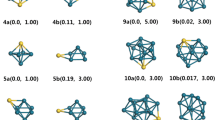Abstract
The geometric structures, relative stabilities, magnetic properties of Mo-doped gold clusters Au n Mo(n = 1–10) have been investigated at the PBE1PBE/def2TZVP level of theory. The results show that molybdenum doping has a significant effect on the geometric structures and electronic properties of Au n Mo(n = 1–10) clusters. For the lowest energy structures of Au n Mo(n = 1–10), the two dimensional to three dimensional transition occurs at cluster size n ≥ 8, and their relative stabilities exhibit odd–even oscillation with the change of Au atom number. It is found that charge in corresponding Au n Mo clusters transfers from Mo atom to Au n host in the size range n = 1–7, whereas the charge in opposition direction in the size range n = 8–10. In addition, the magnetic properties of Au n Mo clusters are enhanced after doping single Mo atom into the corresponding gold clusters. Our results are valuable for the design of magnetic material.



Similar content being viewed by others
References
H. De Sekhar, S. Krishnamurty, and S. Pal (2010). J. Phys. Chem. C 114, 6690.
M. Boronat, A. Leyva-PÉrez, and A. Corma (2014). Acc. Chem. Res. 47, 834.
N. K. Jena, K. R. S. Chandrakumar, and S. K. Ghosh (2011). J. Phys. Chem. Lett. 2, 1476.
M. Zhang, H. Y. Zhang, L. N. Zhao, Y. Li, and Y. H. Luo (2012). J. Phys. Chem. A 116, 1493.
J. Sui, X. Q. Wang, and P. L. An (2014). Comput. Theor. Chem. 1028, 98.
C. J. Wang, X. Y. Kuang, H. Q. Wang, H. F. Li, J. B. Gu, and J. Liu (2012). Comput. Theor. Chem. 1002, 31.
Y. Gao, X. Dai, S. G. Kang, C. A. Jimenez-Cruz, M. Xin, Y. Meng, J. Han, Z. G. Wang, and R. H. Zhou (2014). Sci. Rep. 4, 5862.
M. A. Shestopalov, A. Y. Ledneva, S. Phane Cordier, O. Hernandez, M. Potel, T. Roisnel, N. G. Naumov, and C. Perrin (2011). Angew. Chem. Int. Ed. 50, 7300.
P. Pyykkö and N. Runberg (2002). Angew. Chem. 114, 2278.
X. Li, B. Kiran, J. Li, H. J. Zhai, and L. S. Wang (2002). Angew. Chem. Int. Ed. 41, 4786.
D. Hossain Jr, C. U. Pittman, and S. R. Gwaltney (2014). J. Inorg. Organomet. Polym. 24, 241.
D. K. Niakolasa, M. Athanasiou, V. Dracopoulosa, I. Tsiaoussisc, S. Bebelis, and S. G. Neophytidesa (2013). Appl. Catal. A Gen. 456, 223.
X. Lian, W. L. Guo, F. L. Liu, Y. Yang, P. Xiao, Y. H. Zhang, and W. Q. Tian (2015). Comput. Mater. Sci. 96, 237.
J. P. Perdew, K. Burke, and M. Ernzerhof (1996). Phys. Rev. Lett. 77, 3865.
B. Chan and Y. L. Yim (2013). J. Chem. Theory. Comput. 9, 1964.
M. J. Frisch, et al. Gaussian 09, revision C.01 (Gaussian, Inc, Wallingford, 2009).
E. D. Glendening, J. K. Badenhoop, A. E. Reed, J. E. Carpenter, J. A. Bohmann, C. M. Morales. Weinhold, F. NBO 5.0. 2001 (Theoretical Chemistry Institute, University of Wisconsin, Madison, WI,) http://www.chem.wisc.edu/~nbo5
T. Lu and F. W. Chen (2012). J. Comput. Chem. 33, 580.
T. Lu and F. W. Chen (2012). J. Mol. Graph. Model. 38, 314.
M. D. Morse (1986). Chem. Rev. 86, 1049.
M. A. Tafoughalt and M. Samah (2014). Comput. Theor. Chem. 1033, 23.
L. Cheng, K. X. Yu, Z. W. Lu, A. J. Mao, and Y. M. Ma (2011). J. Phys. Chem. A 115, 9273.
C. Jackschath, I. Rabin, and W. Schulze (1992). Ber. Bunsenges. Phys. Chem. 96, 1200.
R. G. Pearson Chemical Hardness: Applications from Molecules to Solids (Wiley, Weinheim, 1997).
Acknowledgments
We thank the Shanghai Supercomputer Center for access to the high performance computing service and program support. This work is supported by the foundation of Yan’an University (YDQ2014-32), and the foundation of College of Chemistry & Chemical Engineering of Yan’an University (YDHG2014-Z04). Innovation and entrepreneurship training program of college students of Shaanxi Province (1449). The National College students’ innovative entrepreneurial training plan (201510719288). The National Natural Science Foundation of China (21543017).
Author information
Authors and Affiliations
Corresponding author
Ethics declarations
Conflict of Interest
The authors declare that they have no conflict of interest.
Rights and permissions
About this article
Cite this article
Cao, J., Li, Q., Wang, Z.X. et al. Computational Studies on the Mo-Doped Gold Nanoclusters Au n Mo(n = 1–10): Structures, Stabilities and Magnetic Properties. J Clust Sci 27, 993–1004 (2016). https://doi.org/10.1007/s10876-015-0961-z
Received:
Published:
Issue Date:
DOI: https://doi.org/10.1007/s10876-015-0961-z




